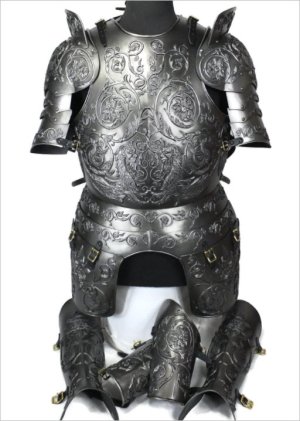Just a small one day project.
I use a Princess Auto Feed Scoop to distribute gravel on the sidewalks I maintain in the winter as a snow angel. I leave a bucket of gravel at a few houses along my route. I like the PA design, but it needs a couple of improvements for my purposes.
Firstly, it is just a tad too large for a typical 5 gallon bucket. In the winter the gravel mix freezes solid so you have to chip away at it with the scoop. The scoop is too large for this, and you can’t get a good angle of attack to break up the gravel inside the bucket. Instead I usually end up having to grab a shovel from my truck, or I scrape it with my gloves—which wears them out pretty fast. A second improvement is needed because the PA model is intended for feeding animals and not chipping ice-bound gravel (or scooping it for that matter)...so the metal is a tad too flimsy.
This is the new version I made. It’s 18 gauge instead of 22 gauge, and slightly smaller so I can fit it in the 5 gallon bucket better to chip with. I also used bulkier ¼” rivets instead of the 5/32” ones on the PA model. The handle and cross brace are more robust as well. The nice thing about 18 gauge (which I use a lot of) is that it’s about as thin as you can go without needing to put a safety edge/hem on the metal, but super easy to weld without blowing through it. That was part of the plan because the PA one is a rolled lip that is just press fit on. It comes off a lot because of the weight of the gravel, so I wanted a welded lid on the new one.
In one of the pics you can see how little working space I have left on the welding table. Next to the Beverley sheer is a Craftex straight sheer. In order to use the Beverley I remove a couple of bolts from the Craftex and pivot that tool to the rear of the table. This gives me lots of room to use the Beverley for almost all of my projects except anything really big. In those cases I just remove the Craftex completely, but that’s a rare event.
Someday I need to make a die for the press in the shape of a finger so I can put indents into round handles (like on bicycle handle grips), but that will be for a future project. It’s one of those “nice to haves” that seems a great idea, but a lot of work for marginal gain.
I haven’t decided if I will paint it or not. We’ll see if I make a couple of more or not first.










I use a Princess Auto Feed Scoop to distribute gravel on the sidewalks I maintain in the winter as a snow angel. I leave a bucket of gravel at a few houses along my route. I like the PA design, but it needs a couple of improvements for my purposes.
Firstly, it is just a tad too large for a typical 5 gallon bucket. In the winter the gravel mix freezes solid so you have to chip away at it with the scoop. The scoop is too large for this, and you can’t get a good angle of attack to break up the gravel inside the bucket. Instead I usually end up having to grab a shovel from my truck, or I scrape it with my gloves—which wears them out pretty fast. A second improvement is needed because the PA model is intended for feeding animals and not chipping ice-bound gravel (or scooping it for that matter)...so the metal is a tad too flimsy.
This is the new version I made. It’s 18 gauge instead of 22 gauge, and slightly smaller so I can fit it in the 5 gallon bucket better to chip with. I also used bulkier ¼” rivets instead of the 5/32” ones on the PA model. The handle and cross brace are more robust as well. The nice thing about 18 gauge (which I use a lot of) is that it’s about as thin as you can go without needing to put a safety edge/hem on the metal, but super easy to weld without blowing through it. That was part of the plan because the PA one is a rolled lip that is just press fit on. It comes off a lot because of the weight of the gravel, so I wanted a welded lid on the new one.
In one of the pics you can see how little working space I have left on the welding table. Next to the Beverley sheer is a Craftex straight sheer. In order to use the Beverley I remove a couple of bolts from the Craftex and pivot that tool to the rear of the table. This gives me lots of room to use the Beverley for almost all of my projects except anything really big. In those cases I just remove the Craftex completely, but that’s a rare event.
Someday I need to make a die for the press in the shape of a finger so I can put indents into round handles (like on bicycle handle grips), but that will be for a future project. It’s one of those “nice to haves” that seems a great idea, but a lot of work for marginal gain.
I haven’t decided if I will paint it or not. We’ll see if I make a couple of more or not first.

